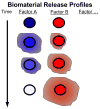Polymers to direct cell fate by controlling the microenvironment
- PMID: 18024105
- PMCID: PMC2262952
- DOI: 10.1016/j.copbio.2007.10.004
Polymers to direct cell fate by controlling the microenvironment
Abstract
Enhanced understanding of the signals within the microenvironment that regulate cell fate has led to the development of increasingly sophisticated polymeric biomaterials for tissue engineering and regenerative medicine applications. This advancement is exemplified by biomaterials with precisely controlled scaffold architecture that regulate the spatio-temporal release of growth factors and morphogens, and respond dynamically to microenvironmental cues. Further understanding of the biology, qualitatively and quantitatively, of cells within their microenvironments and at the tissue-material interface will expand the design space of future biomaterials.
Figures



Similar articles
-
Development and therapeutic applications of advanced biomaterials.Curr Opin Biotechnol. 2007 Oct;18(5):454-9. doi: 10.1016/j.copbio.2007.09.008. Epub 2007 Nov 5. Curr Opin Biotechnol. 2007. PMID: 17981454 Review.
-
Smart biomaterials design for tissue engineering and regenerative medicine.Biomaterials. 2007 Dec;28(34):5068-73. doi: 10.1016/j.biomaterials.2007.07.042. Epub 2007 Aug 15. Biomaterials. 2007. PMID: 17706763
-
A multi-functional scaffold for tissue regeneration: the need to engineer a tissue analogue.Biomaterials. 2007 Dec;28(34):5093-9. doi: 10.1016/j.biomaterials.2007.07.030. Epub 2007 Aug 6. Biomaterials. 2007. PMID: 17675151
-
Glycomics: New Challenges and Opportunities in Regenerative Medicine.Chemistry. 2016 Sep 12;22(38):13380-8. doi: 10.1002/chem.201602156. Epub 2016 Jul 11. Chemistry. 2016. PMID: 27400428
-
Review paper: a review of the cellular response on electrospun nanofibers for tissue engineering.J Biomater Appl. 2009 Jul;24(1):7-29. doi: 10.1177/0885328208099086. Epub 2008 Dec 12. J Biomater Appl. 2009. PMID: 19074469 Review.
Cited by
-
Mechanically-enhanced three-dimensional scaffold with anisotropic morphology for tendon regeneration.J Mater Sci Mater Med. 2016 Jul;27(7):115. doi: 10.1007/s10856-016-5728-z. Epub 2016 May 23. J Mater Sci Mater Med. 2016. PMID: 27215211
-
Dual growth factor-modified microspheres nesting human-derived umbilical cord mesenchymal stem cells for bone regeneration.J Biol Eng. 2023 Jul 10;17(1):43. doi: 10.1186/s13036-023-00360-w. J Biol Eng. 2023. PMID: 37430290 Free PMC article.
-
Embryonic stem cell microenvironment enhances proliferation of human retinal pigment epithelium cells by activating the PI3K signaling pathway.Stem Cell Res Ther. 2020 Sep 23;11(1):411. doi: 10.1186/s13287-020-01923-0. Stem Cell Res Ther. 2020. PMID: 32967731 Free PMC article.
-
Advancing biomaterials of human origin for tissue engineering.Prog Polym Sci. 2016 Feb 1;53:86-168. doi: 10.1016/j.progpolymsci.2015.02.004. Epub 2015 Mar 28. Prog Polym Sci. 2016. PMID: 27022202 Free PMC article.
-
Embryonic anti-aging niche.Aging (Albany NY). 2011 May;3(5):555-63. doi: 10.18632/aging.100333. Aging (Albany NY). 2011. PMID: 21666284 Free PMC article.
References
-
- Fisher JP, Mikos AG, Bronzino JD. Tissue Engineering. CRC Press; 2007.
-
- Ingber DE. Cellular mechanotransduction: putting all the pieces together again. Faseb Journal. 2006;20:811–827. - PubMed
-
- Lutolf MP, Hubbell JA. Synthetic biomaterials as instructive extracellular microenvironments for morphogenesis in tissue engineering. Nature Biotechnology. 2005;23:47–55. - PubMed
-
- Lodish H, Berk A, Matsudaira P, Kaiser CA, Krieger M, Scott MP, Zipursky L, Darnell J. Molecular Cell Biology. 5. W. H. Freeman; 2003.
-
- Cukierman E, Pankov R, Stevens DR, Yamada KM. Taking cell-matrix adhesions to the third dimension. Science. 2001;294:1708–1712. - PubMed
Publication types
MeSH terms
Substances
Grants and funding
LinkOut - more resources
Full Text Sources
Other Literature Sources

